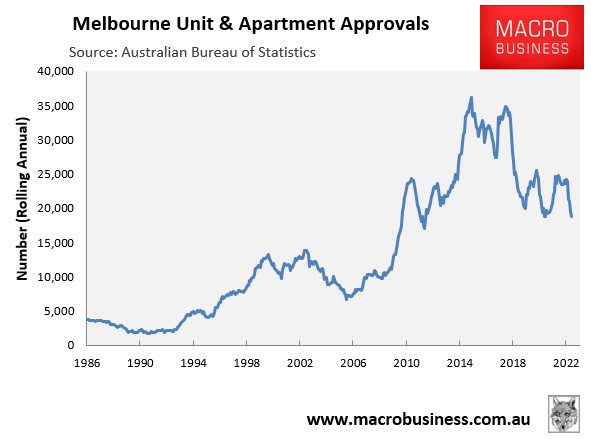Melbourne’s break-neck population growth risks turning the city into an unliveable nightmare.
After growing by an absurd 1.5 million people (44%) so far this century, the latest federal budget forecasts that Melbourne’s population would grow by around 500,000 over the five years to 2026-27.
That represents two Hobart’s worth of population growth in only five years, but obviously without the infrastructure and housing to match.
Indeed, over the next ten years, Melbourne is projected to grow by one million people.
The federal Treasury’s Centre for Population projects that by 2033, Melbourne will have 6.1 million residents, with overseas migrants making up almost three-quarters of these new arrivals.
It would also mean that Melbourne’s population will have nearly doubled since the turn of the century, from around 3.4 million people, primarily via strong net overseas migration.
Victorian Premier Dan Andrews this month told Italian-language community newspaper Il Globo that he wants to federal government to ramp immigration even higher:
“We need to do more as a nation to recruit more of those people to come here, not just for a job, but to build a new life because we all benefit from that. So, I’ve always been a very strong supporter of more skilled migration”.
“And the new federal government have taken some important steps towards increasing the amount of permanent skilled migration, but I think they might need to do more again”.
“Prime minister Albanese knows this. I’ve spoken to him about it personally and part of it also is clearing the Visa backlog”.
With Melbourne’s housing crisis worsening by the day amid the fastest population influx in history, Dan Andrews has announced a plan to squeeze an extra million homes into established suburbs by the middle of the century.
A key plank of Andrews’ plan is to force-feed development by stripping local councils of decision-making powers for major developments.
The Age noted the enormity of this growth task over the weekend:
“Considering there are currently about 2.1 million dwellings in Greater Melbourne, hitting the target will require roughly one new dwelling for every two existing homes within the city’s boundaries”.
“Having taken about 188 years to get to our current situation, accommodating 50% more houses within existing boundaries in the next 20 years represents a major policy challenge”.
Dan Andrews has a poor memory. What occurred when Melbourne built a record number of high-rise apartments in the last decade?

We received a large number of defective and combustible apartments, which the state is still attempting to repair.
The Age recently reported that “inspections of 339 buildings that received government funding to remove flammable cladding found half had other faults and one-in-four had balcony defects”.
“More than 550 balconies were found to be defective”.
“Cladding Safety Victoria is concerned that the situation in relation to defective balconies is widespread and has proliferated over at least two decades”.
“They have been built to an absolute minimum price and a minimum standard”, said Paul Viney, Victorian president of the Association of Consulting Architects.
“I think we will continue to see significant numbers of building defects emerge”.
Other systemic issues have been discovered in Melbourne’s newly built apartments.
What does Dan Andrews anticipate will happen when huge numbers of apartments are erected quickly to cater for Melbourne’s historically high levels of immigration? Is he expecting building standards to remain stable, degrade, or improve?
The response is self-evident: construction standards will be lowered even further to develop apartments as rapidly as possible in order to house the swelling population.
Thousands more faulty high-rise residences will be constructed across Melbourne to accommodate the Albanese Government’s and Dan Andrews’ reckless mass immigration program.
Infrastructure will also become increasingly crush-loaded, with Melbourne residents suffering from reduced access to hospitals, schools, green space and other public services, while also spending longer stuck on congested roads and trains.
The obvious solution to Australia’s (and Melbourne’s) chronic growing pains is to reduce immigration to levels that are proportional to our ability to supply new housing and infrastructure.
Nobody voted for Labor’s massive immigration plan, and the overwhelming majority of voters oppose it. Stop the madness.

